Moments in Disability History 30
Reflections on ADA's 25th Anniversary
The statements that comprise this "Moment in Disability History" were collected from key players who carried the Americans with Disabilities Act to its final passage and are now reflecting on the ADA 25 years later.
Senators David Durenberger (MN) and Tom Harkin (IA) introduced the ADA to the Senate in the 101st Congress on May 9, 1989.
At the 20th Anniversary Celebration of the ADA, former Senator David Durenberger said that the federal legislation had roots in Minnesota law and policy that date back more than 50 years. He also recalled that many people, businesses and advocacy groups said the ADA couldn't be passed for costs and practicality reasons. When told that companies and government couldn't afford to make changes outlined in the ADA, Senator Durenberger's response was "We can't afford not to do it."
Senator Durenberger sends the following updated insight to the signing of the ADA in 1990:
As President George H. W. Bush approached the platform on which he was to sign the ADA bill into law, the band played "Hail to the Chief." All present, who were able, stood to welcome the President who helped make the ADA a reality. Immediately we heard a chorus of voices of those who were unable to stand, yell "Down in front." Said it all right there on the White House lawn!
If I learned anything from my life before the Senate, it was the value of independent living to persons with disabilities from early in life or after serious aging sets in, meaning living in interdependence with a community of supportive persons and public policies. By the time I stood for re-election to my second term in office, I proudly wore a "Durenberger: He's Accessible" button produced by friends in the community of persons with disabilities.
Public policy as bold as a commitment to civil rights relies on timing. The decade of the 1980s had seen particular attention paid to the rights of those with disabilities culminate in a Republican President joining with a Democratic Congress to create and pass the ADA. As a principal co-sponsor, I focused on persuading employers who feared they couldn't afford mandated access that they couldn't afford not to provide it.
This varied from bus companies to restaurants. My task was made easier by finding examples of business leadership already providing access for all, regardless of disability, including a restaurant owner who'd installed special electrical connections for guests whose assistive devices required them.

Senator David Durenberger
Justin Dart stated that his wife, Yoshiko Dart, was the force behind his fight for the Americans with Disabilities Act. Justin was a civil rights warrior with a voice like thunder. Yoshiko is quiet and humble. Together they were powerful. Justin passed away in 2002. In Yoshiko, he left behind the spirit of unity, humility, love and empowerment.
Yoshiko sends the following from herself and Justin:
Happy 25 ADA!
Beloved Colleagues in Justice:
I love you! Justin loved you and continues to love you!
It has been our distinct honor, privilege and profound happiness to be soldiers in the struggle for justice, especially for the ADA alongside with you. Thanks to you, we have made a lot of progress in many areas. Yet we are keenly aware we must keep moving forward and upward vigorously toward a realization of the Dream.
Justin was writing his manifesto, vision for the next step, "FROM ADA TO RIE" – Revolution of Individualized Empowerment. Justin Dart's manifesto on the Mouth Magazine website.
I hope and pray you will be able to feel/hear his love and cry. Thank you all from the bottom of my heart for your leadership, dedication to the cause of justice, and friendship and love! It will be my privilege to continue our struggle together until my last days. I love you!
POWER OF LOVE AND TRUTH!
POWER OF UNITED ADVOCACY!
POWER OF GLOBAL SOLIDARITY FOR JUSTICE FOR ALL!
RIE! REVOLUTION OF INDIVIDUALIZED EMPOWERMENT!
Lead On!
Yoshiko (and Justin)
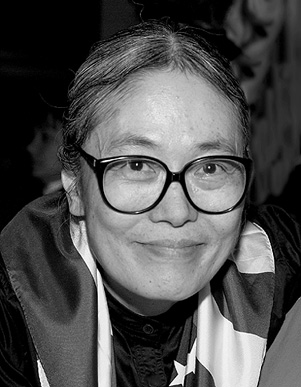
Yoshiko Dart
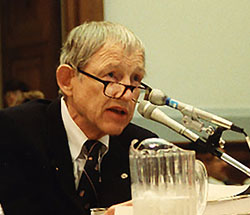
Justin Dart
George Covington, Special Assistant to Vice President Dan Quayle, was among leadership in the White House credited with breaching the barriers of tradition to make the ADA happen. Covington was the first person in the Office of the Vice President to have a sign saying "Disability Policy."
Covington's goal was to ensure passage of the ADA. He recommended events for the Vice President's participation that would show case the disability community and at which the Vice President could get up close and personal with Americans with disabilities. One such event was the Paralympics on Long Island, New York, in 1990. Overcoming the Vice President's Advance Team, whose job was to make events "quick and easy", was an issue. Covington succeeded.
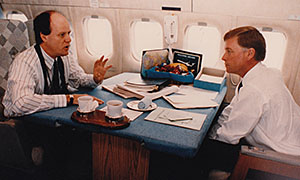
George Covington and Vice President Dan Quayle
Covington insisted that the Vice President be introduced by a person with a disability. Leonard Sawich, Ph.D., aide to the Governor of Michigan, and President of the Dwarf Athletic Association of America, was that person.
Vice President Dan Quayle was the first Vice President to come to such an event. The Vice President and Sawich waded into the crowd of 3,000 athletes, trainers and coaches to shake hands. Covington said Vice President Quayle shook hands with and talked to more people with disabilities than all the previous Vice Presidents in history.
George Covington was the Master of Ceremonies at the picnic in Ellipse Park following the signing of the ADA where he said " …today we stopped being a charity and started being a constituency, and it does make a difference."
Vice President Quayle was at the top of the list of ADA supporters introduced by Pat Wright at the 26th of July picnic in Ellipse Park following the ADA signing ceremony. Vice President Quayle spoke of the new era ushered in by the ADA, " …an era in which disabled people will have greater control over the decisions that affect their lives." The former Vice President reflects on the ADA:

Leonard Sawich, Ph.D.
Throughout my life, I have had the opportunity to meet and know individuals with disabilities. Believe me there is no difference between the attitudes, capabilities, and aspirations of disabled people and those of their non-disabled co-workers. The main distinction is the attitude of society. Too often, negative images, myths, and stereotypes cause employers to underestimate the talents and contributions of qualified job applicants with disabilities.
This is the reason that I actively supported the Americans with Disabilities Act (ADA).
We have made great progress in the last 25 years but there is still a great deal to be done. Today, citizens with disabilities have forums for expressing themselves that were not even imagined when we passed the ADA. Social media allows everyone to reach vast audiences in real time. No one can express the goals and dreams of people with disabilities better than they can themselves.
I have encouraged business leaders to ask workers with disabilities what they want and need. You will be enriched by their responses. Perhaps most important, you will find a whole new group of top-quality employees you may not have known existed—people who are ready, willing and able to do the job. I am proud at what we did in passing the ADA but the fight is not over. The ADA has given us a new beginning and hope for the future…
Dan Quayle
Senator Tom Harkin (IA) was Chair of the Senate Subcommittee on Disability Policy. He worked closely with staff Director Bobby Silverstein and Pat Wright to rewrite the 1988 version and to negotiate consensus positions with the White House, business, colleague Senators, and the disability community. He led the fight in the Senate to maintain the principle of equality. He called the ADA the 20th century emancipation proclamation for people with disabilities. The now retired Senator Harkin reflects upon that time:
It is hard to believe it has been 25 years since the passing of the Americans with Disabilities Act (ADA). This nation has come a long ways since the passing of this historic civil rights act.
Before the ADA, I heard stories of individuals who had to crawl on their hands and knees to go up a flight of stairs, who couldn't ride a bus because there wasn't a lift, and individuals couldn't attend a baseball game with their own family due to accessibility at the ball park. Millions of Americans were denied access to their own communities – and the American dream.
I saw this firsthand in the life of my older brother Frank, who was deaf. He was the inspiration for my sponsoring the ADA, and my lifelong work on disability rights. We've come so far as a country since passage of the ADA.
However, the work is far from over. We must continue the fight for policies that promote equal opportunity, full participation, self-determination, independent living, and economic self-sufficiency for people with disabilities and their families.
Senator Tom Harkin (Ret.)

Senator Tom Harkin
Congressman Steny Hoyer shepherded the Americans with Disabilities Act (ADA) to overwhelming approval in the House in 1990. In 2008, Congressman Hoyer also led the effort to pass the ADA Amendments Act, which allows millions of Americans with disabilities to benefit from the ADA's original intent of inclusion.
When Congress passed the Americans with Disabilities Act twenty-five years ago, it represented a seminal moment in the history of civil rights in our country. For millions, the ADA has meant independence, opportunity, and dignity, and its impact on their lives and the life of our nation is incalculable.
I am incredibly proud to have played a role in enacting this landmark law – as well as in working to strengthen it through the ADA Amendments Act of 2008 when I was Majority Leader. Passing and improving the ADA has been a bipartisan endeavor, and I hope Democrats and Republicans will continue to stand together when it comes to advancing the cause of equality and inclusion for people with disabilities and their families.
We've made so much progress together over the last quarter century, but there is still a great deal of work ahead. I look forward to celebrating the twenty-fifth anniversary of the ADA this summer and to continuing to work with my colleagues and with stakeholders and advocates to make sure that no disability can stand in the way of pursuing the American Dream.
Steny H. Hoyer, United States Representative, Maryland
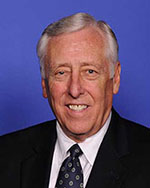
Rep. Steny H. Hoyer
Sandra Swift Parrino, as Chair of the National Council on Disability (NCD), provided leadership to create the Americans with Disabilities Act and was the only female on the dais when President George H.W. Bush signed the ADA.
On July 26, 1990, Evan J. Kemp, Jr. had the honor of introducing President George H.W. Bush at the signing ceremony for the Americans with Disabilities Act. He introduced President Bush as "the foremost member of the disability community."

Sandra Swift Parrino
Twenty-five years later, President Bush reflects:
Signing the Americans With Disabilities Act into law will remain one of the proudest moments of our administration. We reached out and worked in a true spirit of bipartisanship to get that landmark legislation done, and in so doing gave tens of millions Americans a fairer shot at the American Dream. Even today, the ADA is still bringing Americans together to focus not on our differences, but on what unites us as a people.
Now that I need a wheelchair to get around, I know firsthand how cut curbs, ramps, and other provisions of the ADA help mitigate the barriers to vast segments of society. I certainly did not envision being a beneficiary when fighting for the Act's passage, of course, but it has been gratifying to see how it is helping people in all kinds of situations.
Indeed, President Bush was, and is, the foremost member of the disability community.
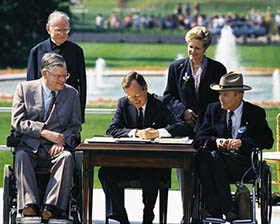
The signing ceremony for the ADA





